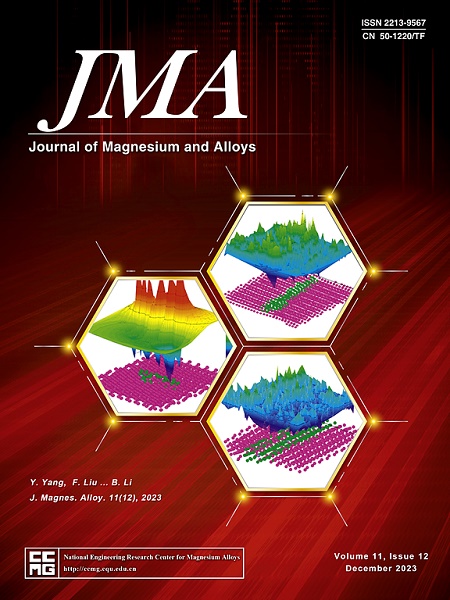Effect of unusual texture on tension-compression asymmetry for Mg-RE alloy by viscoplastic self-consistent modeling
IF 13.8
1区 材料科学
Q1 METALLURGY & METALLURGICAL ENGINEERING
引用次数: 0
Abstract
The tension-compression asymmetry presents notable challenges for the application of magnesium alloys in many fields. In this study, the solid-solution treated Mg-8.5Gd-4.5Y-0.8Zn-0.4Zr alloy's tension-compression asymmetry was examined using optical microscope (OM), x-ray diffraction (XRD), viscoplastic self-consistent (VPSC) modeling, and electron backscatter diffraction (EBSD). The VPSC hardening parameters were significantly adjusted based on the Schmid factor of deformation modes in rare earth magnesium (Mg-RE) alloy, which came from the EBSD data. Excellent agreement was found between the modified VPSC model's calculation results, especially the stress-strain curves and pole figures. The alloy exhibited good strength with a negligible tension-compression asymmetry and an impressive 0.98 ratio of compressive yield strength to tensile yield strength (CYS/TYS). The main cause could be attributed to the unusual texture of (11-20) <0001> in alloy, which eliminated the imbalance in tension and compression deformation by having a negative effect on the activation of {10-12} twinning in tensile and a positive effect in compressive deformation. The activation level of {10-12} twinning was 0.37 and 0.40 calculated by VPSC model, in the plastic deformation of tension and compression, respectively; in the tensile and compression samples, the EBSD data indicated that approximately 31.9% and 31.1% (area proportion) of the grains were deformed with twins, respectively. Both tension and compression deformation showed the {10-12} twinning in the early stage of deformation, which transformed to {11-22} twinning in the later stage. The considerable activation of pyramidal <c+a> during the later stages of deformation endowed the alloy with good ductility.

异常织构对Mg-RE合金拉压不对称性的影响
镁合金的拉压不对称性给镁合金在许多领域的应用带来了显著的挑战。本研究采用光学显微镜(OM)、x射线衍射(XRD)、粘塑性自一致(VPSC)模型和电子背散射衍射(EBSD)对固溶处理Mg-8.5Gd-4.5Y-0.8Zn-0.4Zr合金的拉压不对称性进行了研究。基于EBSD数据得出的稀土镁(Mg-RE)合金变形模式的Schmid因子,对VPSC硬化参数进行了显著调整。修正后的VPSC模型的计算结果,特别是应力-应变曲线和极点图的计算结果吻合得很好。该合金具有良好的强度,可忽略拉压不对称,抗压屈服强度与抗拉屈服强度之比(CYS/TYS)为0.98。主要原因可能是(11-20)<0001>;在合金中,通过在拉伸中对{10-12}孪晶的激活产生负作用而在压缩变形中产生正作用,消除了拉伸和压缩变形中的不平衡。在拉伸和压缩塑性变形中,通过VPSC模型计算得到{10-12}孪晶的激活水平分别为0.37和0.40;在拉伸和压缩试样中,EBSD数据表明,分别约有31.9%和31.1%(面积比例)的晶粒发生孪晶变形。拉伸变形和压缩变形在变形初期均表现为{10-12}孪晶,在变形后期转变为{11-22}孪晶。锥体<;c+a>;在变形后期,合金具有良好的延展性。
本文章由计算机程序翻译,如有差异,请以英文原文为准。
求助全文
约1分钟内获得全文
求助全文
来源期刊

Journal of Magnesium and Alloys
Engineering-Mechanics of Materials
CiteScore
20.20
自引率
14.80%
发文量
52
审稿时长
59 days
期刊介绍:
The Journal of Magnesium and Alloys serves as a global platform for both theoretical and experimental studies in magnesium science and engineering. It welcomes submissions investigating various scientific and engineering factors impacting the metallurgy, processing, microstructure, properties, and applications of magnesium and alloys. The journal covers all aspects of magnesium and alloy research, including raw materials, alloy casting, extrusion and deformation, corrosion and surface treatment, joining and machining, simulation and modeling, microstructure evolution and mechanical properties, new alloy development, magnesium-based composites, bio-materials and energy materials, applications, and recycling.
 求助内容:
求助内容: 应助结果提醒方式:
应助结果提醒方式:


